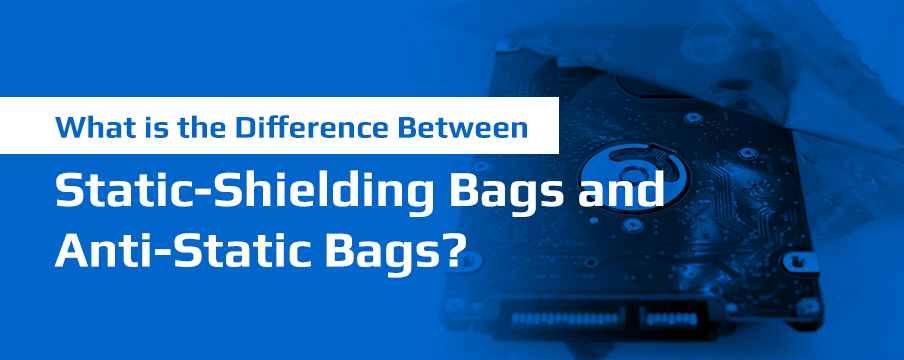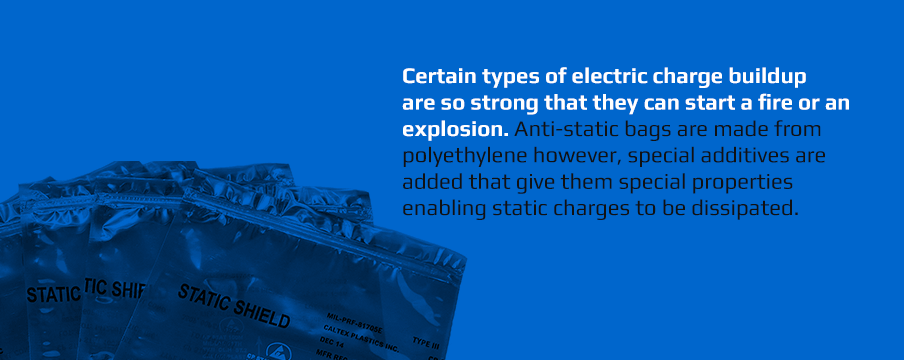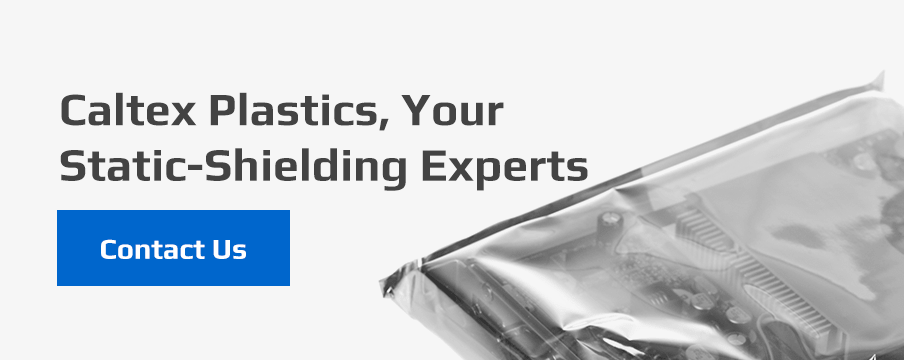STATIC SHIELDING VS ANTI-STATIC BAGS: WHAT'S THE DIFFERENCE?

Posted: January 23rd, 2020 Author: Jim Higgs
TABLE OF CONTENTS
Static Shielding Bags
How Do Static Shielding Bags Work?
What Are Static Shielding Bags Used For?
Pros
Cons
Types of Static Shield Packaging
Anti-Static Bags
How Do Anti-Static Bags Work?
What Are Anti-Static Bags Used For?
Pros
Cons
Types of Anti-Static Packaging
Static Shielding Bags Vs. Anti-Static Bags
Anti-static bags are only static dissipative, whereas static shielding bags are both static dissipative and static shielding by means of a Faraday cage. When a static charges come in contact with anti-static bags, the charge is quickly shed with no build-up of static — however, the charge could penetrate the wall of the bags and contact the packaged devices. Static shielding bags for electronics and similar devices provides a shield for the packaged devices from penetrating static.
Anti-static bags and static shielding bags will protect electronics from electrostatic discharge (ESD). ESD and moisture could impact the functionality of electronic devices and can shorten their life. Proper packaging will keep your contents dry and will protect electronics from static discharge.
We will help you discover which type of static resistant bag is right for the transportation, shipping and handling of your electronics item. Below are the unique features, materials and use of both anti-static and static shielding bags.
WHAT ARE STATIC SHIELDING BAGS
Static shielding bags can be used for shipping, transportation or storage of static sensitive electronics. Some devices are so sensitive to electricity that even the static shock from human touch could limit functionality. Sealed static shielding bags will guard your electronic devices against ESD related damage by eliminating static build-up created by the rubbing of surfaces, also called tribocharging. Additionally, by the Faraday cage effect, charges are prevented from penetrating the wall of the bags.
HOW DO STATIC SHIELDING BAGS WORK?
An ESD can occur when there is an excess buildup of static electricity. The material within static shielding bags contain multiple layers, including a metalized protective layer. The metalized layer creates a Faraday cage effect around the packaged electronic devices.
The Faraday cage effect acts as a shield against external static electric fields, in addition, the static dissipative coating on both the inside and outside layer of the bag continually remove and prevent the build-up of static electricity.
WHAT ARE STATIC SHIELDING BAGS USED FOR?
Static shielding bags prevent the buildup of static electricity and are ideal for transporting and packing static sensitive items such as:
- Printed circuit boards (PCBs)
- Disk drivers
- Resistors
- Memory cards
- Populated circuit boards
- Processors
- Semiconductors
- Other sensitive integrative circuits (ICs)
PROS
Static shielding bags provide an extra measure of protection when compared to anti-static bags. Static shielding bags protect electronics from exposure to static electricity and also protect electronics against an ESD from penetrating the wall of the bag. The multi-layer construction provides a good moisture barrier when the bag is heat sealed closed. Static shielding bags can also be a part of a fire prevention program where strong static charges are in proximity to flammable items.
CONS
Static shielding bags must be completely sealed or closed in order to be fully effective. It’s important to exercise an extra measure of caution when shipping sharp objects that could compromise the integrity of the bag.
TYPES OF STATIC SHIELD PACKAGING
Static shielding bags are both static dissipative and static shielding, but there is another level of protection to be had in a Moisture Barrier Bag (MBB). An MBB provides all the benefits static shielding bags do, plus protection against moisture or water vapor. The bags must be heat sealed and sometimes vacuum sealed. Also MBB are typically much thicker and have greater puncture resistance than static shielding bags.
ANTI-STATIC BAGS
As electronic devices become smaller, they become more sensitive to ESD. Anti-static bags protect electronics from static electricity and are most commonly pink but are available in clear.
HOW DO ANTI-STATIC BAGS WORK?

Static electricity stays in one place and builds up over time. Anti-static bags have special additives that give them a dissipative property preventing the build-up static electricity. Certain types of electric charge buildup are so strong that they can start a fire or an explosion.
Anti-static bags are made from polyethylene however, special additives are added that give them special properties enabling static charges to be dissipated.
WHAT ARE ANTI-STATIC BAGS USED FOR?
Anti-static bags are useful for transporting any static-sensitive device but also for non-static sensitive components that will be transported to a static sensitive environment. Because anti-static bags serve companies with advanced electronics and even military grade electronics, they are ideal for the transportation, packaging and storing of ESD sensitive items.
PROS
Anti-static bags provide a low-cost method of protecting electronic devices and when produced with sufficient thickness, are physically protective and puncture resistant.
Anti-static and conductive packaging, when used together, is essential for the well-being of your electronic devices and the people around you. Static charges could potentially spark other items, causing even more damage. Anti-static and black conductive packaging guards devices against damage during storage, transportation and in a retail setting.
CONS
Anti-static bags are only static dissipative and will not protect a component from an ESD but will dissipate the charge quickly. Also, the polyethylene make-up does not provide a moisture barrier or prevent oxidation.
TYPES OF ANTI-STATIC PACKAGING
For an anti-static bag alternative, you could use anti-static bubble wrap and other types of sheeting. Look for materials that are pink in color, as they are polyethylene, used to make anti-static bags.
STATIC SHIELDING BAGS VS. ANTI-STATIC BAGS
Both static shielding bags and anti-static bags can efficiently protect electronic devices and other cargo from static electricity. Consider the items you want to store within when deciding which ESD packaging will work for you. Static shield packaging is the best and safest way to package, ship and store electronics. Anti-static packaging is a lower cost alternative, but it does not provide the greatest protection.
Determine what type of bags you will use based on the product you are shipping and where you are sending it. Static shield packaging is essential for transporting or packing static sensitive electronics. They also comply with the industry’s requirements for safe and efficient ESD packaging. If you are shipping products to a static controlled area but they are not sensitive to ESD, you can ship them with anti-static bags.
CALTEX PLASTICS, YOUR STATIC SHIELDING EXPERTS

At Caltex Plastics, we can help you figure out which type of ESD packaging is best for your business. As a static-shielding bag manufacturer, we have a wide variety of products with properties that protect against contamination, water damage, air, static electricity, and oxidation. Our large, multi-layered ESD bags will give your electronic items the protection they need to stay safe during transportation and storage.
We offer both static shielding bags and anti-static bags. We also provide static shielding rolls, bubble wrap and other anti-static material. Visit our website and contact us to find out information about our ESD packaging products.